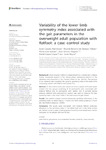Mostrar o rexistro simple do ítem
Variability of the lower limb symmetry index associated with the gait parameters in the overweight adult population with flatfoot: a case-control study
| dc.contributor.author | López-López, Daniel | |
| dc.contributor.author | Casado-Hernández, Israel | |
| dc.contributor.author | Becerro-de-Bengoa-Vallejo, Ricardo | |
| dc.contributor.author | Losa Iglesias, Marta Elena | |
| dc.contributor.author | Gómez Salgado, Juan | |
| dc.contributor.author | Bayod-López, Javier | |
| dc.date.accessioned | 2023-07-21T10:46:46Z | |
| dc.date.available | 2023-07-21T10:46:46Z | |
| dc.date.issued | 2023-06 | |
| dc.identifier.citation | Casado-Hernández I, Becerro-de-Bengoa-Vallejo R, Losa-Iglesias M, Gómez-Salgado J, López-López D and Bayod J (2023), Variability of the lower limb symmetry index associated with the gait parameters in the overweight adult population with flatfoot: a case-control study. Front. Bioeng. Biotechnol. 11:1189309. doi: 10.3389/fbioe.2023.1189309 | es_ES |
| dc.identifier.uri | http://hdl.handle.net/2183/33378 | |
| dc.description.abstract | [Abstract] Background: Adult acquired flatfoot is characterized by a medial arch collapse during monopodal support in the stance phase, developing eversion of the calcaneus and abduction of the forefoot linked to the hindfoot. The purpose of our research was to analyze the dynamic symmetry index in the lower limbs comparing patients with flatfoot and normal foot. Methods: A case-control study was carried out with a sample of 62 participants divided into two groups consisting of 31 participants were overweight with bilateral flatfoot and 31 participants with healthy feet. A portable plantar pressure platform with piezoresistive sensors was used to measure the load symmetry index in the lower limbs in the foot areas and gait phases. Results: Gait pattern analysis showed statistically significant differences in the symmetry index for lateral load (p = 0.004), the initial contact phase (p = 0.025) and the forefoot phase (p < 0.001). Conclusion: The adults were overweight with bilateral flatfoot evidenced alterations in the symmetry index in the lateral load and in the initial contact and flatfoot contact phases, showing greater instability in overweight adult flatfoot compared to the people with normal feet. | es_ES |
| dc.language.iso | eng | es_ES |
| dc.language.iso | spa | es_ES |
| dc.language.iso | por | es_ES |
| dc.language.iso | cat | es_ES |
| dc.publisher | Frontiers | es_ES |
| dc.relation.uri | 10.3389/fbioe.2023.1189309 | es_ES |
| dc.rights | Atribución 3.0 España | es_ES |
| dc.rights.uri | http://creativecommons.org/licenses/by/3.0/es/ | * |
| dc.subject | Adult flatfoot | es_ES |
| dc.subject | Pie plano adulto | es_ES |
| dc.subject | Gait patterns | es_ES |
| dc.subject | Patrones de marcha | es_ES |
| dc.subject | Musculoskeletal disorders | es_ES |
| dc.subject | Desordenes musculoesqueléticos | es_ES |
| dc.subject | Instability | es_ES |
| dc.subject | Inestabilidad | es_ES |
| dc.subject | Lower extremity | es_ES |
| dc.subject | Extremidad inferior | es_ES |
| dc.title | Variability of the lower limb symmetry index associated with the gait parameters in the overweight adult population with flatfoot: a case-control study | es_ES |
| dc.type | info:eu-repo/semantics/article | es_ES |
| dc.rights.access | info:eu-repo/semantics/openAccess | es_ES |
| UDC.journalTitle | Frontiers in Bioengineering and Biotechnology | es_ES |
Ficheiros no ítem
Este ítem aparece na(s) seguinte(s) colección(s)
-
GI-UDISAP - Artigos [196]






